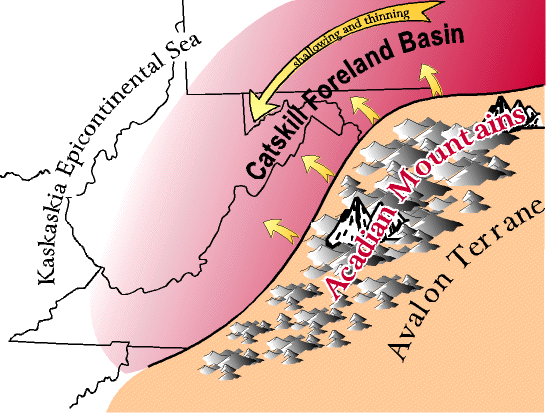Acadian Climatic Patterns
The Acadian mountains were built when the Avalon terrane collided with the east coast as a hinterland. Note the suture in the cross section where Larussia and Avalone join.
During the Devonian, eastern North America lay in the southern trade wind belt between 10-20 degrees south (Old Red map). Winds blowing across the Rheic ocean picked up moisture, but were forced to rise when they hit the mountains. As the winds rose they cooled, formed clouds, and dumped all their moisture as rain and snow, a process called orographic rainfall. The trade winds that got over the mountain were dry and so the foreland basin was in a rain shadow, resulting in an arid to semiarid climate. Or, it may have been monsoonal (heavy seasonal rains followed by many dry months.) Under these conditions the rivers feeding the clastic wedge and Kaskaskia sea may have been ephemeral, that is dry most of the year and flowing only with the occasional storms that brought heavy rain.
Continuing out into the Kaskaskia sea (Old Red map) we head toward the equator and the doldrums, a zone of no winds, but heavy daily rain caused by moisture laden air rising each day to form clouds because of the intense equitorial sun. Under these conditions the epicontinental sea probably had very little wave activity, and may have been dead calm and placid much of the time.
Further discussion of Devonian climate found on the main Acadian page.
Detail of Catskill Foreland Basin
Further discussion of formations and environmental interpretations in the clastic wedge can be found on the main page, the detail page, and the environmental interpretation page.
|

